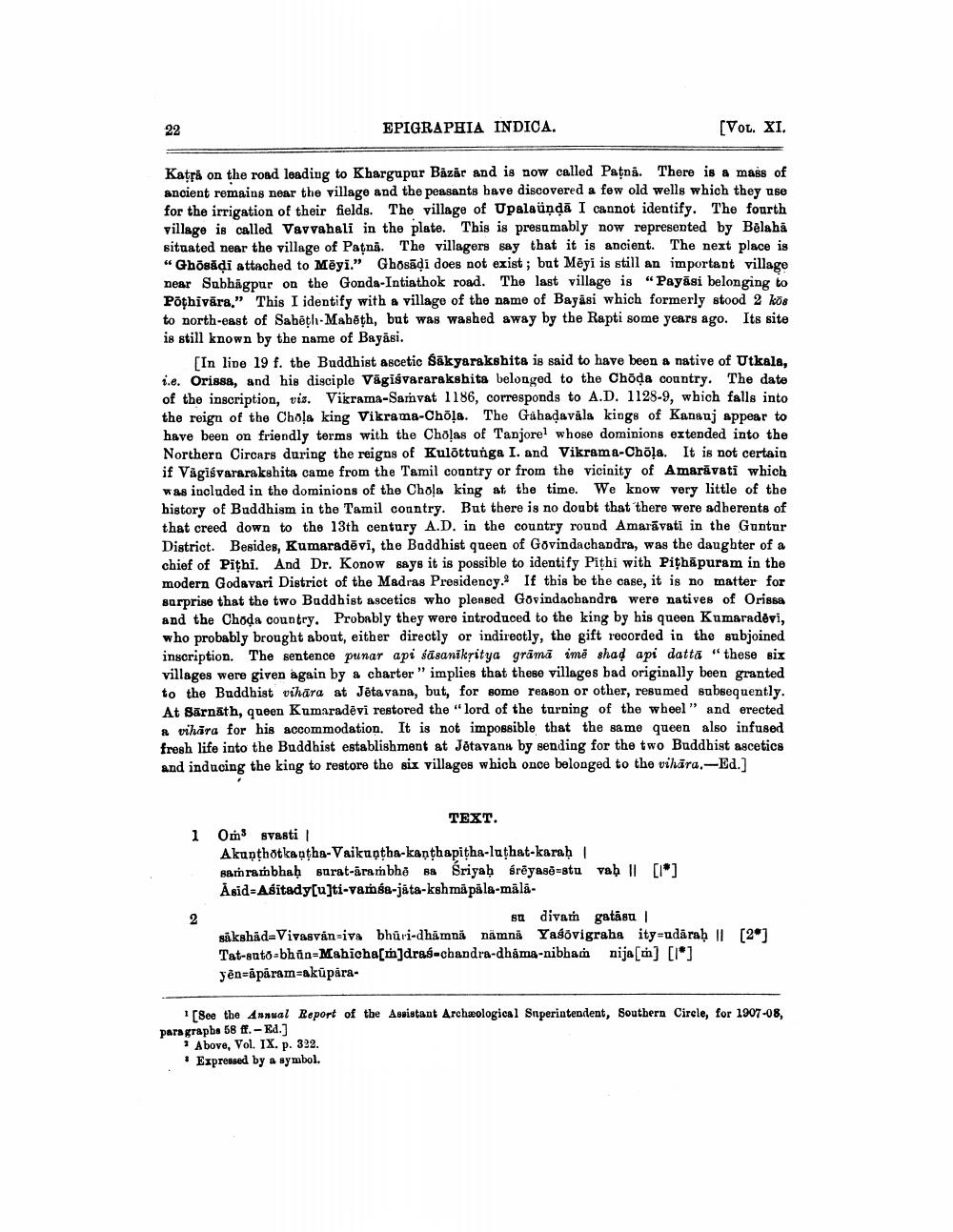________________
EPIGRAPHIA INDICA.
[Vol. XI.
Katră on the road leading to Khargapur Bazār and is now called Patna. There is a mass of ancient remains near the village and the peasants have discovered a few old wells which they use for the irrigation of their fields. The village of Upalaündā I cannot identify. The fourth village is called Varvahali in the plate. This is presumably now represented by Belaha situated near the village of Patna. The villagers say that it is ancient. The next place is “Ghosādi attached to Mēyi." Ghosādi does not exist; but Méyi is still an important village near Subhägpur on the Gonda-Intiathok road. The last village is "Payāsi belonging to Pothivära." This I identify with a village of the name of Bayäsi which formerly stood 2 kos to north-east of Sabētli-Maboth, but was washed away by the Rapti some years ago. Its site is still known by the name of Bayāsi.
[In line 19 f. the Buddhist ascetic Sākyarakshita is said to have been a native of Utkala, i.e. Orissa, and his disciple Vägišvararakshita belonged to the Choda country. The date of the inscription, vis. Vikrama-Samvat 1186, corresponds to A.D. 1128-9, which falls into the reign of the Chola king Vikrama-Choļa. The Gahadavala kings of Kansuj appear to have been on friendly terms with the Cholas of Tanjorel whose dominions extended into the Northern Circars during the reigns of Kulottunga I. and Vikrama-Chöļa. It is not certain if Vägisvararakshita came from the Tamil country or from the vicinity of Amarivati which was included in the dominions of the Chola king at the time. We know very little of the history of Buddhism in the Tamil country. But there is no doubt that there were adherents of that creed down to the 13th century A.D. in the country round Amarāvati in the Guntur District. Besides, Kumaradēvi, the Baddhist queen of Govindachandra, was the daughter of a chief of Pithi. And Dr. Konow says it is possible to identify Pithi with Pithāpuram in the modern Godavari District of the Madras Presidency. If this be the case, it is no matter for surprise that the two Buddhist ascetics who pleased Govindacbandre were natives of Orissa and the Choda country. Probably they were introduced to the king by his queen Kumaradevi, who probably brought about, either directly or indireotly, the gift recorded in the subjoined inscription. The sentence punar api sāsaniksitya grāmā ime shad api datta "these six villages were given again by a charter" implies that these villages bad originally been granted to the Buddhist vihāra at Jēta vana, but, for some reason or other, resumed subsequently. At Sarnath, queen Kumaradēvi restored the " lord of the turning of the wheel" and erected & vihāra for his accommodation. It is not impossible that the same queen also infused fresh life into the Buddhist establishment at Jētavanu by sending for the two Buddhist ascetics and inducing the king to restore the six villages which once belonged to the vihāra.-Ed.]
1
TEXT. Om svasti! Akunțhötkantha-Vaikuntha-kanthapitha-luthat-karaḥ | Barn rambhaḥ surat-aram bho sa Sriyab śrêyaso-stu vab 11 [l] Asid-Asitady[u]ti-vamsa-játa-kshmäpäla-mala
su divam gatást säkshädVivasván-iva bhüri-dhamni nämna Yagovigraha ity-udarah 11 [2] Tat-auto-bhän-Mahicha[m]dras-chandra-dhama-nibham nija[min] [lo] yên=aparam=aküpåra
[See the Annual Report of the Assistant Archæological Snperintendent, Southern Circle, for 1907-08, paragraphe 58 ff. -Ed.)
? Above, Vol. IX. p. 322. · Expressed by a symbol.




